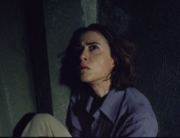Marie Colvin, the late American war correspondent for the Sunday Times, is now the subject of a new biography, In Extremis: The Life and Death of the War Correspondent Marie Colvin by her Channel 4 News colleague Lindsey Hilsum, and two films released just weeks apart. Both cover much of the same violent terrain, but they are quite different in how they approach and view the journalist.
Made for the BBC Storyville documentary series, the illuminating Under the Wire is factual and provides much-needed background regarding Colvin’s career while zeroing in on her last assignment in Homs, Syria, in the winter of 2012, as 28,000 civilians were trapped under the heavy bombardment by the Bashar al-Assad dictatorship. Based on Marie Breener’s 2012 Vanity Fair article, the biopic A Private War, on the other hand, is sensorial. Documentary filmmaker Matthew Heineman (City of Ghosts) makes his feature debut, and the jittery, explosive-filled scenes set on many warfronts give the viewer a jumpy, you-are-there adrenaline rush. They are the best sequences in the movie that can’t escape the biopic trap of summarizing its subject and her motivations.
A Private War’s portrayal of Colvin is a riddle to solve: Why, after a long career in journalism, would she return repeatedly to scenes of devastation and danger? Whereas in the documentary, Colvin comes across as more clear-eyed about her agenda: to bring awareness to those who cannot tell their stories, mainly women and children, and to underreported conflicts. As her feature film counterpart says, news is “the rough draft of history. You have to find the truth behind it.”
Photojournalist Paul Conroy accompanied Colvin throughout the world and in 2012 to Syria. He was severely injured in the same mortar attack that killed her and French photojournalist Rémi Ochlik. Journalist, Edith Bouvier of Le Figaro, was also critically injured after President al-Assad’s military targeted their media compound. Conroy, who has written the book that forms the basis for the documentary, Under the Wire: Marie Colvin’s Final Assignment, is the main talking head here, and much of the swagger that he describes of Colvin matches the portrayal of Rosamund Pike’s amped-up performance in A Private War. He’s joined by her editor Sean Ryan and Hilsum as well.
Conroy credits Calvin for saving the lives of thousands of women and children in East Timor in 1999, when she stayed behind in a shelter after UN forces had evacuated. This was at a time when no Western journalist had been in Sri Lanka in eight years. Her presence prevented a militia from attacking the civilians. It was there where she lost her left eye in a rocket-propelled grenade attack in 2001.
The documentary offers little by way of biographical information. Instead, it focuses on her work, whereas A Private War analyzes her motivations and depicts her as a probable alcoholic with PTSD, her volatile love life, hyper-competitiveness, and as obsessive. Among its assets, Under the Wire paints a fuller picture of those on the ground who aided Colvin and Conroy, namely their go-between Wa’el, who led them into an area of Homs while it was under bombardment, Baba Amr. Its reenactments of wartime chaos seamlessly weave in with the real news footage and are as riveting as the reporting under fire captured in the feature film. (They were filmed in Morocco, while Jordan stood in for Syria for the feature film.) Yet A Private War goes deep into Colvin’s other assignments: 2003 Iraq before the U.S.–led invasion, where she and Conroy reported on the discovery of a mass grave of men murdered by the Saddam Hussein regime; southern Afghanistan in 2009; and Libya, where she interviewed Col. Muammar el-Qaddafi not long before his fall and execution.
In addition to its armchair analysis, A Private War offers a lead performance that calls attention to itself. Instead of suggesting that she’s Colvin, Pike and her director go all-out with a literal interpretation, which including a not very convincing wig for Pike. The actress focuses heavily on speaking with Colvin’s lower pitch and speech pattern while clinging to mannerisms, though in the past, her work has been free-flowing, such as in Hostiles and Gone Girl. The audience is aware of an actor giving a thought-out performance. (A wonderfully understated Jamie Dornan plays Conroy.)
For those who have seen A Private War, Under the Wire is required viewing, particularly for Conroy’s harrowing account of what happened after Colvin’s death as he and his French colleagues waited it out, with no water, little food, under the deliberate mortar attacks by al-Assad’s forces. The two films are not competing for the same scoop. They contain similar facts, just different outlooks. For its concise reporting as well as credible re-creations, Under the Wire is the more necessary film, and despite the bloodshed depicted, it definitely offers hope: Conroy, whose leg was badly injured, no longer reports from conflict zones, but he is still at work—and alive.

















Leave A Comment